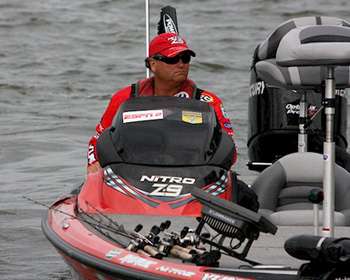
We've all heard the term "turnover" used to describe an annual fall event on many of our favorite lakes. Bubbly water, floating vegetation that's generally related to the bottom of the lake or a stagnant sheen on the surface are all clear indications that the lake is experiencing turnover.
Elite Series pro Matt Reed maintains that the fall turnover can be among the most challenging scenarios an angler can face. "It's a really difficult situation," he says. "Basically, the top and bottom layers of the lake just roll over.
As a result, you're really limited to options on where to fish and techniques that might prove successful." Turbidity and the absence of a thermocline, or an overall reduction of oxygen throughout the water column, are two of the biggest obstacles anglers face when approaching a lake in turnover, but Reed admits that bass can still be caught.
Finding them, however, can compare to finding a needle in a haystack. "Main lake bass can become completely unpredictable when a lake turns over," he says. "They can be suspended anywhere in the water column and just not relating around much of anything. If you can find a bass in open water and get a bite, you're likely to spend the rest of the day looking for another one." It's for this reason that Reed prefers to go shallow in these conditions.
"During the fall turnover, the shallower fish seem to be less affected and are more aggressive," he says. "You still will have to contend with dirtier water than what you might typically be expecting, but as long as the baitfish are still there, the bass will be there." Baitfish, as Reed suggests, are the central element in a successful outing during the fall turnover. With their presence, a successful day is possible. Without baitfish in the area, you're just hoping to get lucky.
"I usually try to move back into the creeks because that's where the water will generally be a little more stable," he says. "Plus, during the fall of the year, shad are going to be moving toward the backs of the creeks, so it's a dependable pattern." With years of experience on lakes across the country, Reed admits that he has encountered fall turnover a number of times. His success is entirely related to his willingness to seek out baitfish.
"During a tournament years ago on Lake Livingston (Texas), the lake turned over and just got really muddy," he says. "All it did was push the shad against the wood located along the creek channels where bass would pick them off. I had a great deal of success with shad-imitating baits and a jig that day." The bottom line, Reed points out, is to avoid going into panic mode. "If you let yourself get into panic mode, your brain starts running too fast and you overlook the obvious," he says.
"In this situation, it's always best to go back to the basics and isolate where the bait will go. That's where the bass will be."
(Provided by Z3 Media)




